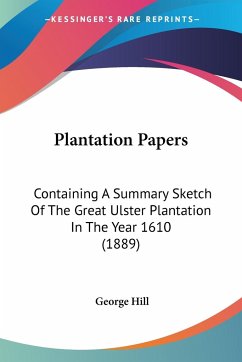
Plantation and Frontier, Vol. II
1649-1863
Versandkostenfrei!
Versandfertig in 1-2 Wochen
36,99 €
inkl. MwSt.

PAYBACK Punkte
18 °P sammeln!
American historian Ulrich Bonnell Phillips (1877¿1934) made a career of studying slavery and the economics of the American South through the 19th century, and he was often criticized by his successors for his emphasis on painting slave masters and plantation owners in a positive light. But even Phillips¿ detractors acknowledge the valuable work he did in bringing to light the priceless original source material from which we can better understand the period. In this two-volume work, first published in 1909, Phillips creates a portrait of the economic life of the South drawn from the details a...
American historian Ulrich Bonnell Phillips (1877¿1934) made a career of studying slavery and the economics of the American South through the 19th century, and he was often criticized by his successors for his emphasis on painting slave masters and plantation owners in a positive light. But even Phillips¿ detractors acknowledge the valuable work he did in bringing to light the priceless original source material from which we can better understand the period. In this two-volume work, first published in 1909, Phillips creates a portrait of the economic life of the South drawn from the details and minutiae found in legal contracts, personal letters and diaries, newspaper articles and editorials, advertisements, plantation records, court records, warrants and affidavits, public notices, city ordinances, and other hard-to-find documents. From the everyday realities of the usage of slave labor to the working conditions of poor whites to the daily routines and management of plantations, what emerges is a unique, on-the-ground perspective of the slaveholding era. Excepts from the table of contents of Volume II: ¿ ¿Slaveholding hard to avoid¿ ¿ ¿The breaking in of fresh Africans¿ ¿ ¿Discipline and riddance of refractory slaves¿ ¿ ¿Negro labor slow and careless¿ ¿ ¿The chase and capture of a slave stealer¿ ¿ ¿Motives and talents of runaway slaves¿ ¿ ¿The barbarism of slavery in the case of light mulattoes¿ ¿ ¿Violence toward masters and overseers¿ ¿ ¿Public opinion regarding free negroes¿ ¿ ¿The negro problem as affected by immigrants¿ ¿ ¿Texan attractions advertised¿ ¿ ¿Association of white and negro labor¿ ¿ ¿Jealousy of white artisans toward negro competition¿












